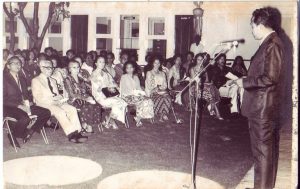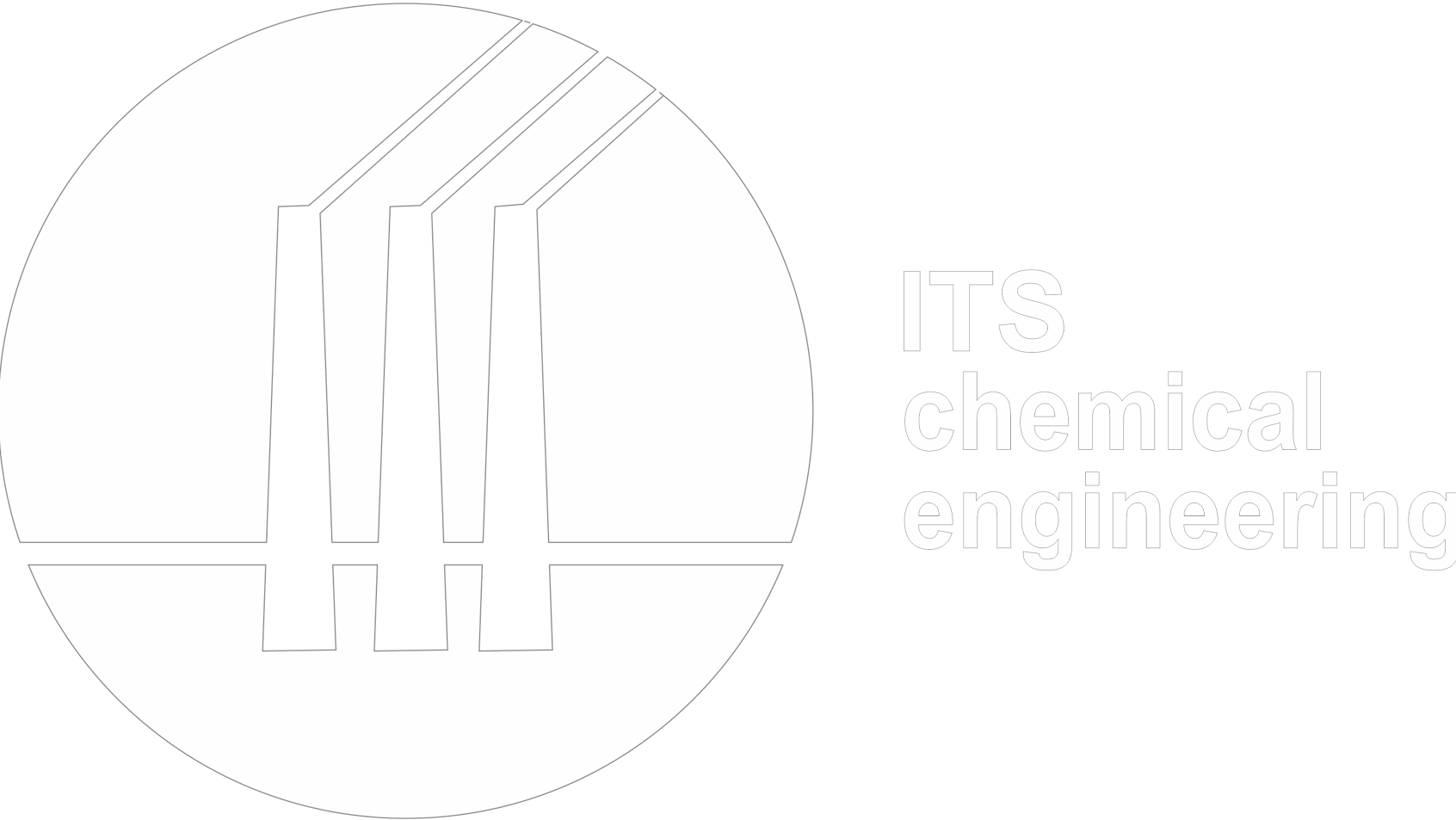
With regard to the legalization of ITS as a state university with 5 faculties, a committee consisting of 10 people was formed based on the decree Si/381/PII/Sg/60. The committee has the task of compiling the curriculum for each faculty. For the Chemical Engineering Faculty who sit on the committee are Ir. Soegeng Soendjaswadi (Former Director of PT IGLAS and Ir. Padio Surjodiningrat. (Former Director of PT Semen Gresik). Then the first head of the Faculty of Chemical Engineering was entrusted to Ir. Soegeng Soendjaswadi considering his expertise in Chemical Engineering. Started Chemical Engineering education at UGM Jogyakarta then took a Masters at AM Institute Technich, Fuel Engineering at Sheffield University in England. Then took Chemical Engineering at Lehigh University, Bethehem, Pennsylvania, United States, became a lecturer at the Faculty of Chemical Engineering UGM and several other important positions such as President Director of PT Iglas member DPR/MPR RI etc. He led the Faculty of Chemical Engineering until March 1963. and died on April 23, 1991. The successor of Ir. Soegeng Soendjaswadi as head of the Faculty of Chemical Engineering was then entrusted to Ir. Soenjoto.
Chemical Engineering is a branch of engineering science that concerns the development and use of the manufacturing process of several materials that undergo physical or chemical changes on a large scale. physical operating units and chemical operating units. The two units then become a reference in preparing the Chemical Engineering curriculum. Some processes that can be expressed in operating units are Heat Transfer Processes, Drying, Extraction, Absorption, Distillation and others. While the process stated in the unit process is an event where materials can be changed from one chemical form to another chemical form by the process of a chemical reaction. The process of learning and understanding material at the Faculty of Chemical Engineering is not only by delivering material in class but also by practice (analysis) in the real world, this activity is carried out in practical work in industry and practical work in laboratories.
At the beginning of the operation of the Chemical Engineering Faculty, you can imagine how big the difficulties were, because teaching staff was difficult to find and educational facilities were minimal. So it is not surprising that in the 1962/1963 school year there was a total traffic jam for the first batch (1960/1961) for one year. However, with the active participation of PII members, the first batch could still run. The condition of the Faculty of Chemical Engineering began to improve when the leadership was held by Ir. Abhimanjoe. At this time the composition of the leadership staff is equipped with the Assistant Deans. Ir. Abhimanjoe led the Chemical Engineering Faculty for approximately 6 months. The leadership of the Faculty of Chemical Engineering is then held by Ir. Soewardjo Adikoesoemo, who previously served as Assistant Dean I. Ir. Soewardjo Adikoesoemo led the Faculty of Chemical Engineering until 1965. Pak Soewardjo was a member of the DPR/MPR then returned to the Department and then he was active as a permanent lecturer in the Department of Chemical Engineering, Universitas Pembangunan Veterans Surabaya. He died in 1999. The first permanent lecturer at the Faculty of Chemical Engineering was Ir. Soelastri Darwati who entered ITS in 1963. In 1965, the number of staff remained at 5 people. However, educational facilities are still minimal.
At the beginning, all practicum activities were carried out in IKIP’s laboratories or known as B1 Chemistry and AAL, then in September 1967 in collaboration with the parents of ITS Chemical Engineering Faculty students, they established a laboratory in the Baliwerti complex. Since then, laboratory activities have been carried out in their own laboratory. In 1967, the Faculty of Chemical Engineering had a Laboratory for Analytical Chemistry, Physical Chemistry, Materials and a Research/Thesis Laboratory.
Education at the Faculty of Chemical Engineering – ITS in 1967 was compiled on the basis of a minimum of 5 years or 10 semesters for undergraduate level, for baccalaureate level (Diploma), carried out for a minimum of 3 years or 6 semesters including practical work and final assignments. It is also regulated, it is intended that prospective chemical engineering graduates can be equipped with sufficient knowledge and training so that they are expected to be able to face the changes and developments of the times. The unit system of lectures used to compose the curriculum at that time was the UNIT system. At that time the curriculum of the Faculty of Chemical Engineering was arranged based on levels, all of which consisted of Level 1 to Level 5.
To graduate as a Chemical Engineering graduate (Engineer or abbreviated as Ir.) a prospective student must pass an entrance test and after being accepted the student must participate in “hazing” activities for one week. This event usually ends with an inauguration night where all attributes are removed and burned in a bonfire. The atmosphere of intimacy between seniors and juniors can be seen in this party. The party does not stop there but usually continues with a friendly night party between the academic community. This party is usually held by the Colombo pool or Tegalsari pool.
After that, students entered college and had to first go beyond PR 200 which at that time became a scourge for all ITS students. The main content of PR.200 is that a student must pass the second level before joining the next level. Students who do not pass the PR 200 are immediately dropped out. Students must go through a total of 273 units to graduate. 273 This unit is divided into several courses, practicum, and final project. As an illustration, the comparison between the SKS system and the Unit system can be exemplified by the Operations Unit course.
With the development of time, in 1978 the Chemical Engineering Faculty located in Baliwerti had several new rooms and laboratories. The rooms that were owned at that time included: lecture rooms, leadership rooms, lecturers’ rooms, library and court rooms, and administration rooms. Meanwhile, the laboratories include: analytical chemistry laboratory, physical chemistry laboratory, microbiology laboratory, organic chemistry laboratory, electrochemistry laboratory, chemical engineering principles laboratory, thesis laboratory and special research laboratory.
At the end of the study session at the Faculty of Chemical Engineering, it ended with an oral exam on Factory Design. Where the examiners consist of lecturers and representatives from PII members. Initially, the oral exam was held in the office of the Chemical Engineering Leader, which occupies the southern part of the Baliwerti campus. Then after the leadership building was completed) in the northern part of the Baliwerti main building, the test was held in the new building.
Since March 27, 1982, the Faculty of Chemical Engineering as a whole moved from Baliwerti to Sukolilo. The ITS Chemical Engineering Faculty occupies Building O in the southern part of the ITS Sukolilo Campus. The dean at that time was Mr. Oedjoe. ADB assistance was not only used to build buildings and send educative staff to study abroad, but also to build a laboratory with all its facilities, especially lab equipment. very needed. At that time the learning concentration was divided into 4 concentrations, namely Factory Design, Equipment Design, Chemical Process and Bio Technology. All lecturers are grouped in these fields to carry out the implementation of the Tridharma such as teaching and research.
Chemical Engineering Faculty Switches to Chemical Engineering Department
In 1983, the Faculty of Chemical Engineering changed to the Department of Chemical Engineering, FTI-ITS. In line with human resource and physical development, the curriculum has also changed. Changes from the Unit System to the Semester Credit System were also carried out in the Chemical Engineering Department since this Faculty was developed with ADB funds. Initially the curriculum was made 160 credits divided into 10 semesters, then in 1990 it changed to 152 credits in 9 semesters and the last curriculum for the Bachelor Level was set to 144 credits. divided into 8 semesters.
Mr. Oedjoe is still listed as the Head of the First Department, then the change process occurred in 1983 where the Head of the Department was led by Ir. Achmad Baktir M Sc. The sending of lecturers abroad continued so that by the late 80’s a number of doctoral staff had returned to ITS including Dr. Nonot Soewarno, Dr. Renanto H. Dr. Achmad Roesyadi and Dr. Rachemoellah.
With the large number of doctoral staff in the Chemical Engineering Department, under the leadership of Dr. Achmad Roesyadi as Head of the Chemical Engineering Department in 1990 the structure of the lecturer grouping was changed to a Research Laboratory based, so that the grouping of lecturers was also changed to a research group in the Research Laboratory. Several Research Labs were established and each laboratory was headed by a head of the lab. And the lecturers grouped into these labs. So in the Chemical Engineering Department there are two groupings of laboratories, namely the Education laboratory where students do regular practicum and the Research laboratory where lecturers and final students conduct research.
In 1991/1992, in the context of the stratification program and technology development, the Department of Chemical Engineering established the Masters Program. It was noted that the head of the first master’s degree program was Dr.M.Rachemoellah. Initially, the master’s program was implemented in the form of collecting master’s credits with ITB. S2 students at that time had to go to ITB Bandung to arrange their study plans, but all training and mentoring was carried out at ITS. In the 1994/1995 college year, the Masters program was fully managed by ITS.
In 1990, Government Regulation No. 30 of 1990, where all Departments of Non-Degree Technology (FNGT) were merged into related departments at the Faculty which held similar programs but at the undergraduate level (S-1). Therefore, the D-3 program, Chemical Engineering. Join the Department of Chemical Engineering FTI.ITS. Thus, since then the Chemical Engineering Department has had two Postgraduate Study Programs and a Diploma Study Program.
In order to improve the quality of Indonesian Human Resources, especially the workforce in Indonesia, the Department of Chemical Engineering FTI-ITS provides opportunities for those who work to study at ITS through the Extension Education Program. This program has been open since the Even Semester 1995/1996 and is held at night. The Department of Chemical Engineering continues to develop, various assistances have also been received. ADB II Assistance The QUE Project IMHERE project complements the development of the Department of Chemical Engineering, especially the development of human resources and the addition of laboratory facilities. Likewise, the number of Chemical Engineering lecturers with PROFESSIONAL TEACHERS participated in the development of this Department. Then after it was deemed adequate, both in terms of human resources and facilities, in 2001, the Doctoral Program in the Chemical Engineering Department was opened. This happened when the Head of the Department was held by Dr. Ir. Sugeng Winardi.
Now, approaching the 50th anniversary of ITS, it means that ITS Chemical Engineering is even 50 years old. The latest data is that this department has 52 teaching staff with 13 professors, 34 administrative staff. Total alumni are 4,200 people, spread throughout the country, serving at all levels of work, in fulfilling the call of the motherland and carrying out and carrying out the mandate of the alma mater. serve for the glory of the nation by always remembering the spirit of November Ten. Vivat Chemical Engineering, Vivat ITS, Vivat Alma mater.
